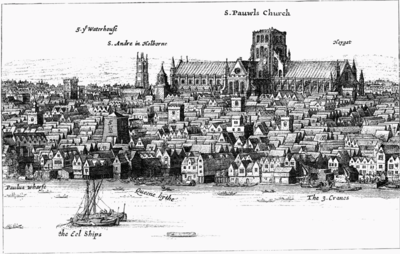Annotation:Paul's Wharf: Difference between revisions
No edit summary |
No edit summary |
||
| (One intermediate revision by one other user not shown) | |||
| Line 1: | Line 1: | ||
---------- | |||
---- | {{TuneAnnotation | ||
|f_tune_annotation_title= https://tunearch.org/wiki/Annotation:Paul's_Wharf > | |||
'''PAUL'S WHARF.''' English, Country Dance Tune (6/4 time). D Major/Mixolydian. Standard tuning (fiddle). AAB (Johnson): ABCD (Chappell). The air was published in the '''Fitzwilliam Virginal Book''' and John Playford's (1623-1686) first edition of his '''English Dancing Master''' (1650-1, adjacent to "[[Paul's Steeple]]"). Chappell credits it to English composer Giles Barnaby and explains that Paul's Wharf was (even at the time he was writing) one of the public places for taking water, located near St. Paul's Cathedral. In '''The Prices of Fares and Passages to be paide to Watermen''', printed by John Cawood, Chappell finds: | |f_annotation='''PAUL'S WHARF.''' English, Country Dance Tune (6/4 time). D Major/Mixolydian. Standard tuning (fiddle). AAB (Johnson): ABCD (Chappell). The air was published in the '''Fitzwilliam Virginal Book''' (c. 1615, No. 113, set by Giles Farnaby) and John Playford's (1623-1686) first edition of his '''English Dancing Master''' (1650-1, adjacent to "[[Paul's Steeple]]"). Chappell credits it to English composer Giles Barnaby and explains that Paul's Wharf was (even at the time he was writing) one of the public places for taking water, located near St. Paul's Cathedral. In '''The Prices of Fares and Passages to be paide to Watermen''', printed by John Cawood, Chappell finds: | ||
[[File:Paul's.png|400px|thumb| | [[File:Paul's.png|400px|thumb|right|Paul's Wharf is identified in the lower left of the 16th century print.]] | ||
<blockquote> | <blockquote> | ||
''Item, that no Whyry manne, with a pare of ores, take for his fare from'' | ''Item, that no Whyry manne, with a pare of ores, take for his fare from'' | ||
| Line 9: | Line 9: | ||
''Westminster, or White hall, or lyke distance to and fro, above iijd.'' | ''Westminster, or White hall, or lyke distance to and fro, above iijd.'' | ||
</blockquote> | </blockquote> | ||
|f_source_for_notated_version= | |||
|f_printed_sources=Barlow ('''The Complete Country Dance Tunes from Playford's Dancing Master'''), 1985; No. 77, p. 32. Chappell ('''Popular Music of the Olden Time, vol. 1'''), 1859; pp. 266-267. Johnson ('''The Kitchen Musician No. 14: Songs, Airs and Dances of the 18th Century'''), 1997; p. 11. Raven ('''English Country Dance Tunes'''), 1984; p. 46. | |||
|f_recorded_sources= | |||
|f_see_also_listing= | |||
}} | |||
Latest revision as of 16:22, 21 August 2023
X: 1 T:Paul's Wharf. (p)1651.PLFD1.077 M:6/4 L:1/4 Q:3/4=90 N:"_key sig 1 sharp in original" S:Playford, Dancing Master,1st Ed.,1651. O:England;London H:1651. Z:Chris Partington. K:D fd2eBc|d>AFE2e|fd^c/d/eBc|d>FED3:| |:FAFGB2|AdB^ce2|fedeBc|d>FED3:|
PAUL'S WHARF. English, Country Dance Tune (6/4 time). D Major/Mixolydian. Standard tuning (fiddle). AAB (Johnson): ABCD (Chappell). The air was published in the Fitzwilliam Virginal Book (c. 1615, No. 113, set by Giles Farnaby) and John Playford's (1623-1686) first edition of his English Dancing Master (1650-1, adjacent to "Paul's Steeple"). Chappell credits it to English composer Giles Barnaby and explains that Paul's Wharf was (even at the time he was writing) one of the public places for taking water, located near St. Paul's Cathedral. In The Prices of Fares and Passages to be paide to Watermen, printed by John Cawood, Chappell finds:

Item, that no Whyry manne, with a pare of ores, take for his fare from Pawles Wharfe, Queen hithe, Parishe Garden, of the blacke Fryers to Westminster, or White hall, or lyke distance to and fro, above iijd.

